WordPress for Beginners Topic Index
Topic Index for "WordPress for Beginners"These are WordPress guides and trainings that TopFiveAdvisor designates for beginner users of WordPress.
These are WordPress guides and trainings that TopFiveAdvisor designates for beginner users of WordPress.
 Once you are established with your new WordPress website, you will likely want to add new users so that they can help you write new content or manage your existing content. Thankfully, WordPress makes this extremely easy. In your WordPress Dashboard, hover your mouse over Users then click All Users.
Once you are established with your new WordPress website, you will likely want to add new users so that they can help you write new content or manage your existing content. Thankfully, WordPress makes this extremely easy. In your WordPress Dashboard, hover your mouse over Users then click All Users.
Once you do that, this page will appear.
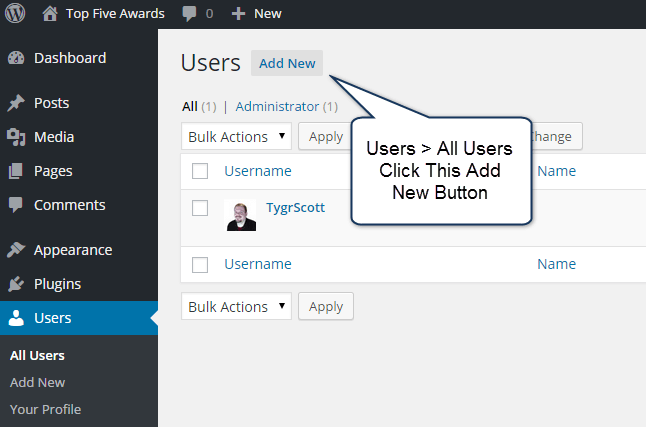
Click “Add New”
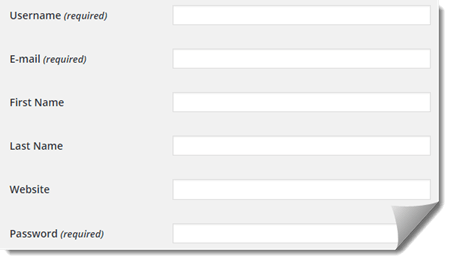 From there, everything is straight forward.
From there, everything is straight forward.
Username: This is used by the new person to log in to your website.
Email: Make sure this is their real email address that way if they forget their password, they can do a password recovery.
First / Last Name: This can be used and displayed on your website depending on your theme.
Make sure you create a very secure password for them to use.
Send Password? This is an option you can use to send the username and password to your new user. We typically do not use this function opting instead to craft our own email that explains how to add new content to the site.
Role: Need help understanding user roles? Click that link to learn about the default user roles to help you understand what they are and what role you should assign.
Then click the “Add New User” button.
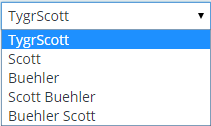 Head back to Users > All Users and click on their username or the edit link below their username. On this page, you can edit the profile name, nickname and as we’re showing here in our screenshot, the Display name publicly as option which is how the name will appear on your front-end pages.
Head back to Users > All Users and click on their username or the edit link below their username. On this page, you can edit the profile name, nickname and as we’re showing here in our screenshot, the Display name publicly as option which is how the name will appear on your front-end pages.
Visual Editor: You may disable the visual editor which is the traditional editor that you use to style your content. If you want to provide an environment for your writers to simply copy / paste text that you will then style yourself, that’d be a great example of why you’d disable the visual editor.
Admin Color Scheme: There’s 8 color schemes for your users to choose from.
Keyboard Shortcuts: Certain user roles allow comment moderation which allows for keyboard shortcuts to be used. You may disable keyboard shortcuts to help prevent your authors from styling comments and to prevent accidental actions like marking a comment as spam with the s key.
Toolbar: The black floating toolbar when viewing your website’s front-end is enabled by default on all logged in users. If you wish, you can disable that toolbar if needed.
There’s a new section here called About Yourself that you or the new user will be able to add or edit their Biographical Info. Depending on the theme you use, you may or may not see this information on the approved content they share.

You may notice that there is an “About Scott Buehler” at the bottom of this page that shares a little information about me. This is all done in the edit profile area in WordPress and you can even add text links using simple HTML as shown below.
He offers <a href="http://www.scottbuehler.com">digital marketing services</a> to any local business
Simply edit the HTML and text and it will be transferred to a text hyperlink that people can click.
Depending on the theme you use and plugins installed, you may notice that there are additional options on this page to fill out for each user. For instance, WordPress SEO, a recommended SEO Tool, will add a WordPress SEO Settings area that will allow you to customize the author page title, meta description and more.
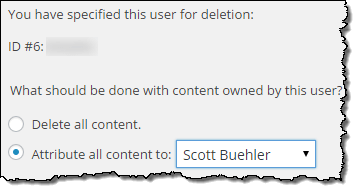 Users > All Users.
Users > All Users.
Hover your mouse over the user and then click the red “Delete” link. This will always take you to the screen shown here where you will have final options to complete before deleting the user.
Delete all Content: For most (with a few exceptions), you should not delete all content because it will remove content from your website causing 404 errors and other issues. If a writer has left your website and you simply want to remove the user while keeping their content, you’d choose the other option.
Attribute All Content to: This will change all of the content under the user being deleted to be attributed / assigned to a different user that you select. While most will simply assign content to the main admin account, you may also consider a <Sitename> Staff username that you assign these posts to so that it doesn’t appear that you, the admin, wrote the content. In our case, this would be our Top Five Advisor Staff account.
Once done, click the Confirm Deletion button and the user will be removed from your website.
Right after launching your first WordPress website, you will likely want to integrate some sort of social media functionality to make it easy for your viewers to share your content on social media. So, you hop on the WordPress Plugin Directory, do a few searches for social media plugins and instantly get that overwhelmed feeling.
There are hundreds of options to choose from and each one has their own pros and cons.
You might even be a great researcher and decide to start reading the reviews and support forums for each social media integration plugin, however, you’ll find yourself spending days deciding and testing various plugins to find the one that is right for you.
Our goal with this guide is to help you save all of that previous time, do the research for you and report our findings. This isn’t your average top list, we’ve downloaded the plugins, installed the plugins, checked how they effect page loading speed and more.
The below plugins are all free to use. Although there are some awesome premium social sharing plugins out there, we’ve kept this guide’s focus on the best FREE social media sharing plugins.

Tested Version: 1.17
Configure: Settings > Floating Social Bar
Supports: Facebook, Twitter, Google+, LinkedIn, Pinterest
Front-End Payload:
fsb.js: 9.27 KB
This plugin loads extremely fast and only requires 10KB of JavaScript to work. The JavaScript allows the user-fieldly popup when someone clicks to share your content.
Socialite is an awesome feature because it allows your social media icons to load on your website without any additional payload from the default scripts that social media websites use. When a user hovers their mouse over a social icon, the button updates then to show the default button. Impressive.
Interval to Update Stats: Because Floating Social Bar does not load the default sharing options on every page load, this plugin needs to store and update the share statistics occasionally. Meaning, if your post gets shared 950 times and you set this option to 30 minutes, any shares that occur during that 30 minute interval will not show until the stats update. However, your posts will still show 950 shares on the share icon.
This is the best of both worlds because you are reducing the heavy payload of traditional sharing icons while still showing statistics to the reader which can (and does) increase sharing. When the user hovers over the share icon, they will get the real number of shares.
Don’t want to float your social bar? This is where the name of this plugin can be deceiving because you are not forced to use the floating options! You can check the option “Make Social Bar Static” and it will disable floating as well as provide you with static options including showing social media icons Above and Below Content, Below Content, or Above Content.

We noticed alignment problems with Socialite enabled on the default Twenty Fifteen theme. Testing on Thrive Themes, Twenty Thirteen and Twenty Fourteen went fine. Socialite adds the social media counter feature so that readers can see how often your posts / pages can be shared. We were able to fix the issue by adding custom CSS to fix alignment, but for most, it will need knowledge of CSS and ability to identify the CSS classes needed to change. You may, or may not, experience alignment problems on your theme after hovering over an icon, especially the Facebook and Google+ icons. If this occurs, you can “Disable Socialite” and the problem will disappear.
We were impressed with floating social bar because there is no direct monetization to add features to your social media sharing experience. The only optimization methods are an email opt-in to get email updates from WPBeginner and an advertisement for Soliloquy, a responsive slider plugin.
Floating Social Bar remains one of our go-to plugin recommendations when a user needs a fast social media integration that is easy to set up and go. If you aren’t using a theme that integrates social media, need a solution that is free and is fast loading on the front-end, this plugin should be a perfect fit.
![]()
Tested Version: 2.3.5
Configure: Mashshare > Settings
Front-End Payload:
mashsb.min.css: 28.2KB
mashsb.min.js: 3.35KB
Total Payload: 31.55KB
* Does not include monetization options.
Supports: Only Facebook and Twitter on the free version (see monetization below).
Note: Not seeing the share icons on your website? Here’s how to enable it right away, go to Mashshare > Settings > Visual Tab > Location & Position Tab. Under post types, check post and page to enable the share options on all posts and pages. Once saved, go to the Social Networks tab and place a check under Facebook, Twitter and Subscribe as desired. Remember to save.
There’s going to be a larger performance hit when using this plugin because it is collecting statistics on your database. You can opt to switch from MashEngine (local data collection) to SharedCount to offload the hit, but this only allows 10,000 free requests before a payment is required.
The other option is to disable the Sharecount option which requires no SQL queries at all. Enable cache expiration of at leasdt 30 minutes to reduce server load as well, they have a 5 minute setting as default which we wouldn’t recommend.
Other optimizations include the ability to force the JavaScript to load at the bottom of your HTML.
An interesting feature of this plugin is that they allow you to fake your statistics by adding a number you specify to the total tally. Shady at best.
For Facebook, you can configure the count to include shares, likes, or all shares, likes and comments on your content.
Under Visual > Customize you will find a lot of options available to customize how your sharing will appear. You will be able to round the share count to the nearest 1K or 1M, animate the share count, change the share count title, add Twitter handle, change share count color, add a border radius to your share icons (rounding effect), add gradients, change the default button width, enable small buttons and customize the Subscribe button link and behavior.
Under the Visual > Location & Position tab you can customize the position of the share icons from Top, Bottom, or Top and Bottom. You’ll also be able to customize where your share options appear including any custom post type, post or page. You can also add share icons to your category pages of front page which is a really nice touch.
As much as we love Mashshare, the plugin is severely limited in functionality for those looking for a free option. By default, you will only be able to add Facebook, Twitter and a “Subscribe” page link on your content. If you want your users to have the option to share to other networks, that’ll cost you. There’s a lot of things that’ll cost you, so here’s the options.
Mash Networks: Want Google+, Whatsapp, Pinterest, LinkedIn, Tumblr, Stumbleupon and other networks? That’ll be €19.00 for one site.
VideoPost Popup: At the end of your embedded video playback, this optin allows a popup to appear to encourage sharing of the video. You can also set this to popup after a specific period of time on the video playback. That’ll be €39.00 for one site.
Facebook Likebar: A sticky mobile-optimized bar that encourages viewers to like your Facebook page. The bar disappears when a user likes the page and offers an X to close the sticky bar should the reader not want to like the page. Mobile optimized and offers many customizations for €19.00 on one site.
Sticky ShareBar: Add a sticky bar that plasters to the very top of the browser window that offers share options. That’ll be €18.00 for one site.
Realtime Pageview Counter: Show how many times your page has been viewed from the point this feature is activated. That’ll be €18.00 for one site.
Google Analytics Integration: €19.00 for one site.
Mashshare Responsive: Be default on the free version, the share icons do not shrink and instead stack on each other. If you want this functionality for your mobile viewers, that’ll be €9.95 for a single site. Come on guys, seriously? This should be a default feature!
URL Shortener: A free enhancement option that allows you to use goo.gl links in Twitter. Mashshare does not recommend this feature currently due to performance issues.
Mashshare LikeAfterShare: Ok, this is actually really cool because when someone clicks your Facebook share button and shares your page, they will be taken back to your site with a new popup that asks for a LIKE on your page as well. A hefty €29.00 pricetag for one site.
Open Graph: Add open graph options to your social sharing. We wouldn’t recommend this because if you’ve installed WordPress SEO, you already have it. This is free to use if needed and allows for your featured images to be used on Facebook and other social media when your content is shared.
They have also added a $24 social locker enhancement that links to CodeCanyon which allows you to encourage sharing on your content to reveal a special download or offer.
Get the Core Add-On Bundle: If you elect to purchase any of the above add-ons, you might want to claim the bundle which includes 7 add-ons for €39 for one site (VideoPost not included). For €99 you can get this for 3 sites and it includes VideoPost.

Tested Version: 1.7.8
Configure: Settings > Social Media
Front-End Payload: No added JavaScript or CSS. Only images.
Supports: Facebook, Twitter, Google+, Reddit, Pinterest, LinkedIn, Tumblr, Email, RSS, YouTube, Vimeo, Instagram, Flickr, Foursquare.
Placement Customizations: After Post, Before Post, Before & After Post.
No floating options.
Clicking an icon forces a a new browser tab to open which is used to share the post to a user’s social media. Since they do not use javascript, there’s no way to make this plugin open a traditional smaller window to share the content.
They only offer one style and do not offer traditional sharing icons with counters to be used. Therefore, readers won’t be able to see engagement or popularity on a post.
We found the settings page to be pretty confusing and somewhat overwhelming. They offer a floating menu on the upper right of the settings page that covers the explanation of features. You must find a small “toggle” link to remove the floating menu so you can read the full descriptions.
Icon size is customizable with 6 sizes. Icon resolution options allow optimization to consume less bandwidth.
Configuring the social media network settings appears daunting. There is 3-5 options to learn and fill out on each social network that allows customization of the type of sharing that will occur, share link (don’t touch), your social media link, title of the share or follow button.
Extra Icon Skins: This plugin only offers one set of icons. If you’d like to use other social media icon sets, there is a €9.99 fee to get “Extra Icon Skins”.
Grey Face Effect: This plugin offers a grey fade effect which is advertised on the plugin download page. €14.99 fee to add this feature. It shows your default social media icons in grey and then when moused over, turns the color on.
Light Prompt Overlay: This adds an overlay which offers different sharing options for the social media network clicked. Example: Facebook, when clicked, offers a small overlay that offers a Like and Share button with a share counter. A €19.98 applies.
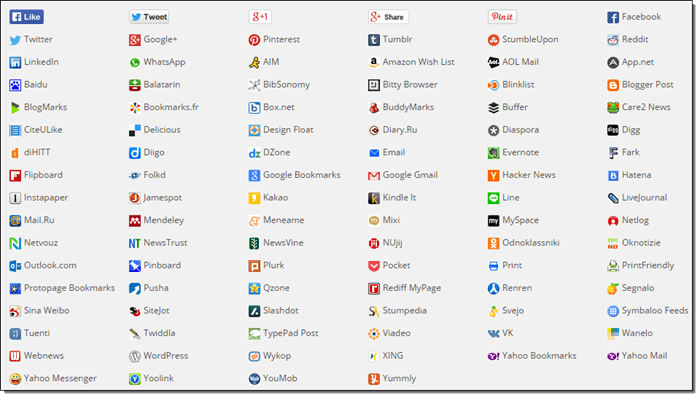
Tested Version: 1.5.8
Configure: Settings > AddToAny
Front-End Payload:
addtoany.min.css: 1.19KB
page.js (external): 23.08KB
Loads external social media integration files on page load.
Payload: At least 25KB.
Want more social sharing options? The AddToAny plugin lives to its name with 100 social media sharing options to choose from. Of course, with great choice comes great responsibility.
For every social media integration you add as a Standalone button, you increase the page load time. The files requested are loaded asynchronously, however, they are always loaded and not loaded upon user request / hover like other plugins listed here.
Our recommendation? Select just a few of the major social media networks you’d like to have as a Standalone button and utilize the integrated + button that will allow your users to choose from the 100 options available.
Placement Options: You can select to disaply the social media icons at the bottom, top, or top and bottom of your posts, pages, front page, archive pages and on custom post types.
Menu Styler: One thing unique to AddToAny is the Menu Styler. This links out to AddToAny’s website but allows you to customize the main color, border color, link text, hover text and background. Once done, you can click “Done, get code” and it will give you code that you can add to the “Additional Options” area of the configuration page.
Floating: AddToAny also features a “Floating” tab on the configuration page which allows you to add a left or right hand vertical floating bar. You can configure this floating element to only display on desktop with XXX pixels width (you customize) and position the element XXX pixels from the top of the screen (allowing for larger headers).
If vertical floating isn’t your glass of beer, then scroll down to the Horizontal Buttons area where you can configure horizontal floating buttons that are docked to the browser window.
This is a very ugly option in our opinion because it docks the floating bar at the bottom of the browser window on the far right or left. If the reader is viewing your content on a maximized window on a large screen, the bar may appear way outside of your content.
We reviewed the plugin and found no attempts at monetization. There’s no advertisements or requests for donations. The only thing the author asks for at the bottom of the configuration page is a positive rating and to share it to others.
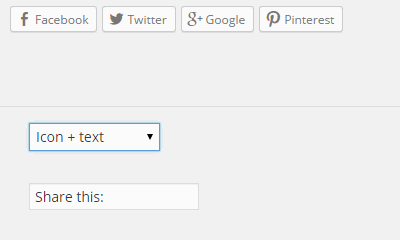
Tested Version: 3.5.3
Front-End Payload:
Loads 3 files on your site.
sharing.js 41.4 KB
sharing.css 16.9 KB
genericons.css 26.8 KB
Payload: 85.10 KB
Configure: Jetpack Menu > Sharing > Activate
Then Visit: Settings > Sharing
JetPack is a massive collection of enhancements and features for your WordPress website. One of those options happens to be a social media sharing option that allows you to add quick and easy sharing icons to your site. As shown to the upper right, you can select Icon + Text, Icon only, Text only or opt to use the default official sharing buttons provided by the social media networks.
JetPack doesn’t offer much in the form of customizations. The social sharing bar will only appear below the content with JetPack. If you are looking for a plugin that offers floating, this plugin is also not for you.
Social Media Support: Facebook, Twitter, Google+, Pinterest, LinkedIn, Reddit, StumbleUpon. Tumblr, Pocket, Email and Print.
Overall, Jetpack social media integration is very cut and dry. It adds a no-frills approach to adding social media to your website but does a minimal job to help your site increase social media sharing.
One huge benefit to JetPack is it brings familiarity to new WordPress website owners that have transferred from WordPress.com to their own WordPress.org installation. For those users, they can add most of the functionality they were used to on WordPress.com using JetPack, which is an official WordPress / Automattic plugin.
As expected, there is absolutely no attempts at monetization with this plugin with the Sharedaddy options.
We hope that the above list will help narrow down your social media integration plugin decision and get you on the important path of creating valuable content that people want to share.
Be careful out there. You will find old lists of recommended social media plugins that recommend plugins that haven’t been updated in over a year. At the time of this review, the popular sharing plugin Digg Digg, with almost a million downloads hasn’t been updated since July of 2013. If you look over their reviews, there’s a lot of complaints which can be expected from an abandoned plugin.
If you’ve found this guide useful, please consider sharing this page on social media using our integration.
You are correct, that’s because at the time of writing this guide, we aren’t using a social media plugin. Instead, we chose to use the social media integration provided by Thrive Themes. For us, social media integration was painless and easy because the theme did exactly what we wanted and knocked out one plugin we didn’t need to add to the site. Additionally, the sharing integration is optimized for fast load and isn’t too distracting for our readers.
The goal of this WordPress Guide is to help those who have decided to create a new user in their WordPress installation. This is not a comprehensive and exhaustive list of features of each default user role, but this is a quick reference that can be used to answer the common question What user role should I assign this user account I am creating in WordPress?
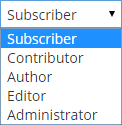 There are 5 default user roles that ships with your WordPress installation. In this guide, we will quickly cover what these roles mean to your new user, what they can do on your WordPress dashboard (permissions) and help you decide which role to select.
There are 5 default user roles that ships with your WordPress installation. In this guide, we will quickly cover what these roles mean to your new user, what they can do on your WordPress dashboard (permissions) and help you decide which role to select.
With no further delay, let’s get started.
This user has no additional rights to your WordPress dashboard. They can only read your posts which is also traditionally available to unregistered users as well. Typically, this role is often assigned and used by membership plugins and, if you so choose, will also be assigned to users when you open registrations under WP Dashboard > Settings > General > Membership (check) Anyone can register.
If you want a higher degree of control on your website, you can disable commenting to unregistered users and require registration which would also take advantage of the subscriber role. We recommend keeping commenting available to everyone and use our guide to help control comment spam should that be an issue.
If you are manually setting up a user on a WordPress site that doesn’t have additional membership software, you’ll likely not need this role.
This would likely be the default role you’d assign to a new writer on your website. They can write and manage their own posts but can only submit those posts for review by an Administrator or an Editor.
When a Contributor creates a new post on your website, they will see a blue Submit for Review button instead of a Publish button. There will be no illusion that what they write will automatically appear on the site without first going through an approval process.
If you plan on establishing a review and approval workflow that all authors will submit content and then get approved by an Editor, you do not want to use the Author user role, instead, you’d place all authors under the Contributor role.
Otherwise, if you do not want an approval process and allow your writer(s) to directly publish content on your website without editorial control, you’d set them up under the Author user role.
As you can see, the Editor role has a lot of power over your website and should only be assigned to people that you trust. You would assign the Editor role to someone as part of a review and approval workflow with the Editor being the one who approves all content submitted by Contributors.
If you are currently running your WordPress website (which is likely why you are on this guide in the first place), you are already familiar with the Administrator role because that is exactly what your access login is.
If you add another user as an administrator, they will have the exact same rights as your account including the ability to delete any users (including your own administrator account).
There is another role that most won’t see or have access to and is the Super Administrator. This is an administrator of a WordPress Multisite / Network setup that has multiple sites installed under a single WordPress database. The large majority of WordPress sites do not use or need WordPress Multisite and is beyond the scope of this guide.
Now that you are getting the hang of WordPress, your site is live, you’ve started adding content and then it happens, you want to scale it up and bring on additional staff to help you write content and do various tasks to help your site grow at an even faster pace.
When you start looking into it, you find out about User Roles and access it by going to WP Dashboard > Users. Inevitably, you’ll start adding test users into the system, log out, log in under the new users and see what they can do on your site that you’ve worked so hard on.
Then you discover that the default user roles are great, but it isn’t perfect. You like X role but you can’t setup new accounts under it because it allows them to do Y, which you only want administrator accounts to manage.
For both options below, we strongly recommend reviewing the WordPress Codex for Roles and Capabilities to have a full understanding of the roles and capabilities before making changes. On that page, consider scrolling down to the Capability vs. Role Table section and have a look at their visual representation of the default roles that WordPress ships with. Just to save a little confusion for you, “Super Admin” is a role that is only offered on WordPress Network / Multisite install which allows you to run multiple “sites” in one WordPress website.
Additionally, consider copying the default roles and modifying those to your liking. Then you can set your users to those roles and never use the WordPress defaults. This way, you can reference the default roles and capabilities at any time.
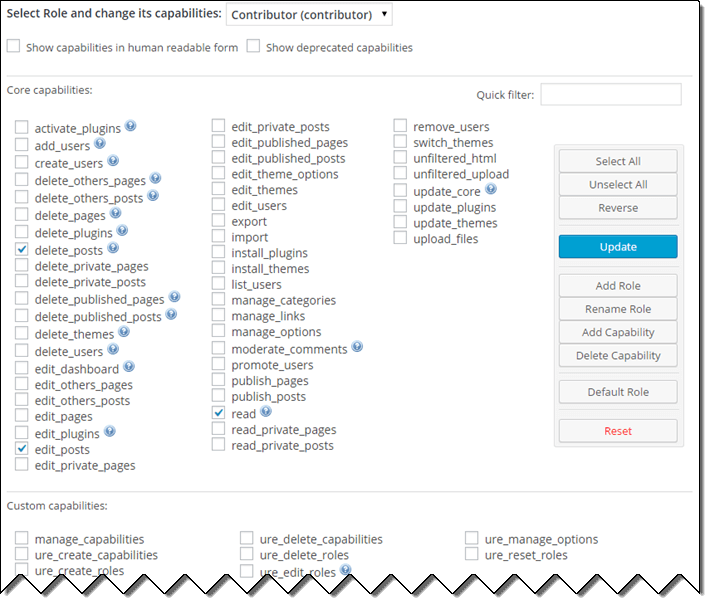
The above screenshot is exactly how User Roles Editor works within your WordPress and is accessed by going to WP Dashboard > Users > User Role Editor. Of course, you can check the box that says Show capabilities in human readable form if you wish, that will just remove the underscore and make the options plain text (we don’t recommend this because then it is a little harder to cross reference the roles and capabilities codex linked above).
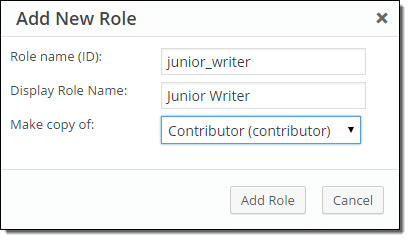 From this screen, you can easily “Add Role,” “Rename Role,” and even do more advanced things like add or delete capabilities for these roles. As we show you on the right, adding a new role is straight forward. Enter the role name, what it displays and select what default role you’d like this role to mimic before you begin editing its capabilities.
From this screen, you can easily “Add Role,” “Rename Role,” and even do more advanced things like add or delete capabilities for these roles. As we show you on the right, adding a new role is straight forward. Enter the role name, what it displays and select what default role you’d like this role to mimic before you begin editing its capabilities.
From here, you can quickly reference the capabilities enabled (checked) and modify how that role works on your website when they log in.
If you’d like to have your senior writers have advanced access to your website, like publishing posts created by junior writers but you don’t quite trust them enough to be a full “Editor” on your site, you can quickly create a Senior Writer role by making a copy of the “Author Role,” reference the codex and enable a few select Editor capabilities and call it a day.
The same thing with your editors. You can create a new editor role and create a “Super Editor” role that would have a select few administrator rights.
Or, go the other way (like what we do) and create an Author role but remove certain default features we don’t want them to have, such as the ability to delete posts.

Immediately after activating this plugin, it will create new capabilities inside of your database, even if you do not make a single modification or change. The above screenshot was taken right from our localhost install when using Capability Manager Enhanced (below) which shows obvious entries added by User Role Editor using the name ure_ as the capability name. Unfortunately, the developer doesn’t offer a way to remove these newly added references upon removal or with the “Reset” function which resets all user roles back to default. If you Reset > Deactivate > Uninstall User Role Editor, the ure_ references remain. Just something to be aware of, which may or may not bother you as an administrator.

Capability Manager Enhanced is, for the most part, the same as the User Role Editor plugin we showed first. The difference here (and why it is included) is the fact that it is a bit more user friendly in the way it portrays the capabilities in an easier-to-understand format.
Of course, the downside with this is also that you are going to have a harder time cross-referencing the codex page to learn exactly what some of these Other WordPress Core Capabilities do exactly.
After the plugin is installed, you can access this plugin by going to WP Dashboard > Users > Role Capabilities.
One thing nice about this plugin is you can completely disable capabilities within a role using the red X without having to delete the capability (which is how URE works).
No revert option available. One of the features mentioned on this plugin’s description page is the ability to revert roles and capabilities to WordPress defaults, however, we thoroughly searched the support threads, reviews and looked over the plugin and do not see a way to do this within the settings. In fact, we had to load URE and use their reset function to remove all the changes we made in this plugin.
Copying roles is a little less user friendly and less obvious compared to URE above. In order to accomplish copying a role, you will need to “Load” a role, like Author and then under Copy Author Role, you type in the name of the new role that you want created. In URE, you simply click “Add Role” then it asks for the name as well as a drop-box to select the user role you want to copy, which is way more straight forward and less confusing.
We’d love to hear how you are using modified or new roles in your WordPress setup. Leave a comment below to help our readers understand the benefits of creating specific roles.
Now that you have your WordPress installed either using our tutorial on manually installing WordPress or our fully automated WordPress install method, the next step is to setup your WordPress settings so that your website will perform as you expect.
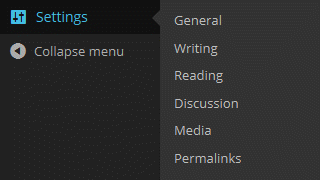 In this guide, we walk you through all of the default settings of WordPress and also cover the WordPress dashboard main screen. In the video below, we cover the general, writing, reading, discussion, media and permalinks settings and also go over why we make the recommendations that we do.
In this guide, we walk you through all of the default settings of WordPress and also cover the WordPress dashboard main screen. In the video below, we cover the general, writing, reading, discussion, media and permalinks settings and also go over why we make the recommendations that we do.
Keep in mind that these recommendations are what Scott Buehler recommends. If you believe your site will benefit from different settings, then do it! Setting up these settings now, although tedious and boring, will help you down the line because you’ll be able to focus on what actually matters, your content!
Since we are covering each setting section in detail, this video is much longer than the majority of our training videos, sorry about that.
Other options including configuring what day the week starts on and your preferred site language.
Post via e-mail is an interesting feature if you prefer to write your blog posts via email instead of using the WordPress editor. You’ll want to keep the email address you configure as secret so that other people can’t send it email and have their post appear on your website. For security reasons, I do not use this feature.
In this section, I go over my recommendations in the video which effects how people interact with your content (the commenting system).
Those are the main things you should consider updating. You definitely want to keep the emails enabled when you receive comments, that way you’ll be alerted when someone makes a comment so you can get into your dashboard and approve / reply to them ASAP.
Enable moderation so that you have full control over the comments that appear on your website. If you don’t manually approve comments and simply leave must have a previously approved comment on, a spammer can make several helpful posts to your website and then later return with a ton of spam that will automatically approve on your site. Just something to be aware of.
Another technique I use to prevent spam is to set the hold comment for moderation option to 1 link so that when someone makes a comment on your site, if they include even one link, they will wind up in the moderation queue. You only need to worry about this option if you decide to leave “” unchecked.
The blacklist is a neat feature because you can setup comment words, names, emails and IP addresses to automatically be marked as spam when received.
Avatars
This feature is awesome. If someone has setup a Gravatar with their email address, when they place a comment on your website, their icon will display along with their comment right on your website. For most users, set the maximum rating to G, set the “Mystery Person” Avatar and call it a day.
The default avatar icon will only display for users who have not setup a Gravatar for their email address.
For most users, you can leave this page as is. Only if you need to change the thumbnail and other media sizes will you need to go in here and setup custom image sizes to fit your needs. When you install premium or custom themes, the authors will typically make use of their own image size settings anyway.

Organize my uploads – This option should be left unchecked, that way your post images will be organized by when you upload them to your website. Otherwise, you are going to end up with a massive single subdirectory on your site with thousands, even millions, of images in the same folder. This can and will cause problems for your server down the road.
This is arguably the most important section you’ll need to update. WordPress allows you to customize the web URLs on your website so that they are more eye-catching and friendly to your users. Again, we will use our blog here to show how important this is.
Which one looks better to you?
or https://www.t5a.com/wordpress/?p=132
When sharing your URL around the web including social media, the first URL actually tells your users what your content is about whereas if they saw the default opton (the second option above), they would have no idea what your content was about or, more importantly, if they want to click that link and see what you wrote.
Our recommendation is to set this to “post name” so that your post name is used as your URL.
If you made it this far and have configured your website, congratulations!
Now that you’ve conquered the most boring part of setting up your website, now we get to move on to learning how to create content, how to change your theme and much more. It’ll be way more fun from here on out so congrats for getting this done.
One of the biggest hurdles people face when wanting to start their website is actually getting it started. There are thousands of people online willing to do it for you that cost more money than many people’s budgets and they end up frustrated, never to launch their dream project.
The first thing they will do is look for guides that teach people how to install WordPress manually which can confuse and frustrate them. They simply do not want to go through that entire process and look for an easier way.
In this guide, we’ll walk you through some of the easiest methods to install WordPress that we’ve found that have left people saying “Whoa, it’s that easy!?!” Yes, it is that easy. Let’s begin, shall we?
If you have no hosting yet and truly just starting out, you are in luck! What if we told you that there is a host out there that will automatically setup your WordPress with no effort on your end? All you’d need to do is order your hosting and click on a radio button that says “Install WordPress” and boom! Your brand new web hosting account will have WordPress automatically setup for you!

It can’t be that simple Scott Buehler, can it? Absolutely. Let me show you right now:
Around the 3 minute mark in this video, I begin to show you the entire ordering process with InMotion Hosting web hosting. On the very last page of the ordering process, you’ll find the “Install WordPress” option. As long as you don’t miss that, you are golden.
 Sounds expensive Scott. How much? This is the best part. If you use our site and link below to order, you’ll get over 50% off their normal pricing. This is an exclusive offer that we have because I spent years getting to know their staff and company. Take advantage of it now!
Sounds expensive Scott. How much? This is the best part. If you use our site and link below to order, you’ll get over 50% off their normal pricing. This is an exclusive offer that we have because I spent years getting to know their staff and company. Take advantage of it now!
Your total price you will pay with no add-ons is just: $47.94 for a full year of web hosting. It’s absolutely crucial to understand that InMotion Hosting is not a discount cheap host out to cram as many customers on a server as possible making your site load slowly. Not at all, in fact, the price you’d pay without our link is more than double. Additionally, I use and trust their web hosting on several of my own projects.
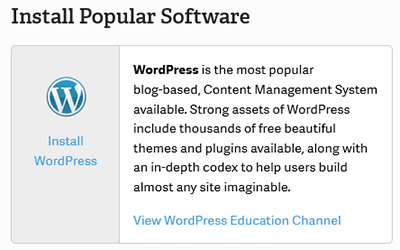 If you already have a web hosting plan, you may still be in luck to get WordPress setup and running with little hassle. Head over to your web host’s sales pages and look for mentions of anything that references an installer for the most popular Internet software. If you see that, you are in luck!
If you already have a web hosting plan, you may still be in luck to get WordPress setup and running with little hassle. Head over to your web host’s sales pages and look for mentions of anything that references an installer for the most popular Internet software. If you see that, you are in luck!
If your web host mentions this, they probably have a 3rd party solution in their control panel called Softaculous or Fantastico. Both of these solutions will install WordPress on any domain setup on your web hosting plan in a matter of a couple clicks. The best part? You can take advantage of these services for free.
Once you find the Fantastico or Softaculous icon on your control panel (after logging in), you simply click that and you’ll see something similar to the image I shared with you in this section. Simply click the Install WordPress option, fill out your new blog’s information and let the installer do everything for you.
Examples of popular hosts that offer this type of free service include Web Hosting Hub review, A Small Orange Review, SiteGround review, HostGator Review and Bluehost Review. These are just a small sampling of hosts that offer an auto-installer for WordPress that you can take advantage of.
Lastly, if you have your heart set on a host that does not offer any of the solutions we’ve talked about on this page, we will do it for you! As long as you order your web hosting from our site, we will gladly setup your WordPress for you for no additional cost. All you need to do is copy and paste your hosting order receipt to us in our contact form and request WordPress setup and we will take care of everything for you.
People that will typically fall into this category have chosen a much higher quality web hosting solution such as a VPS Hosting or even a dedicated server and they didn’t opt to pay monthly for Softaculous (which can be extremely expensive over the years of your plan).
Questions or Comments?
If you have any questions or comments about the process of getting WordPress setup for you, please leave it below. Scott is monitoring this post for any questions and will respond personally to anything you need.
One of the most frequent questions we receive in our client work is about WordPress.com versus WordPress.org. Specifically, which version do I need? Why is one better than the other? What are the pros and cons of each system? What do you recommend?
Both systems, WordPress.com and WordPress.org are confused frequently. In this WordPress guide, we will go through both systems so that you will have a full understanding of each system to help you make an informed decision about which system is right for you. We want you to feel confident in your decision so if you have any questions at all, please feel free to ask in the comments section at the bottom of this guide.
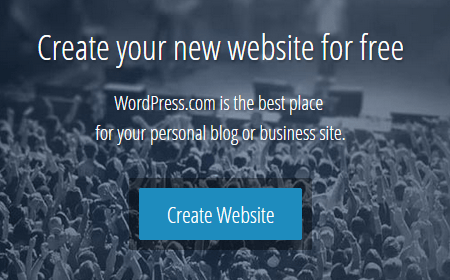 What is WordPress.com? The WordPress.com website is a commercial site that allows you to create and host a site for free. It includes the ability to use your own domain name, they provide the web hosting for you and they offer add-ons to enhance your experience.
What is WordPress.com? The WordPress.com website is a commercial site that allows you to create and host a site for free. It includes the ability to use your own domain name, they provide the web hosting for you and they offer add-ons to enhance your experience.
If you do not have a domain name, your website will use a subdomain on the WordPress.com website similar to https://tygrscott.wordpress.com where tygrscott is your username you select during the account creation process.
WordPress.com runs on the WordPress.org software which is important to understand. The WordPress.com website is simply a hosted solution that runs the WordPress content management system, however, if you choose WordPress.com, you will be locking yourself into a set amount of themes, set amount of available plugins and no way to customize your theme PHP files to enhance your website. The system, put plainly, is locked down.
WordPress.com Pros
WordPress.com Cons
Once you have setup your free website, you’ll notice in the backend that they have a “Store” option which includes enhancements to the free plan which you should be aware of. Most will setup their website, spend months writing content and then they will find out that they will need to pay in order to access certain features. Let’s go over these enhanced plans now:
As you can clearly see, the easiest way to setup a website isn’t always the best way to go. At one point or another, you will need to upgrade your plan to enable certain features that are blocked on the free plan. Whether you need to add a domain name, remove ads, upgrade to a professional theme, or heck, customize the theme to your liking, you’ll have to dig out your wallet.
Remember, with WordPress.com, your content is subject to their Terms of Service. If they designate your content to be spammy, includes threats, uses any form of spammy links to drive traffic, they find your content misleading, your site generates content via automated methods and many other reasons, your site will get shut down.
By submitting Content to Automattic for inclusion on your Website, you grant Automattic a world-wide, royalty-free, and non-exclusive license to reproduce, modify, adapt and publish the Content solely for the purpose of displaying, distributing and promoting your blog. This license allows Automattic to make publicly-posted content available to third parties selected by Automattic.
The above quote is taken right from their Terms of Service as well. Your content is not under your full control like it would be if you hosted your own WordPress website. Additionally, WordPress.com includes a reblog feature that allows any WordPress.com user the ability to repost your content on their website.
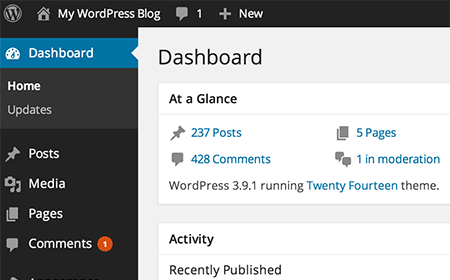 What is WordPress.org? An open source content management system that powers 22% of the Internet now including T5A.com. WordPress.org is the website you visit to freely download the latest version of their software including installation files.
What is WordPress.org? An open source content management system that powers 22% of the Internet now including T5A.com. WordPress.org is the website you visit to freely download the latest version of their software including installation files.
Almost all of the guides and tutorials for WordPress on TopFiveAdvisor is based on the WordPress.org software that is installed on your own web hosting provider. Many web hosts include access to an automated WordPress installer which means WordPress on your own web hosting is about as easy as WordPress.com. If you happen to have a higher quality VPS hosting service that doesn’t offer a WordPress installer, you can use our installing WordPress manually guide.
WordPress.org Pros
WordPress.org Cons
If you are just getting your feet wet, don’t care about making money from your website and just want to setup a quick personal blog, your choice is best with WordPress.com. However, considering all the fees you’ll likely face as you get more serious with your website, there may come a point where you’ll wish you started with your own hosted WordPress installation.
Therefore, for the majority of viewers who are unsure, we highly recommend starting with the solution that gives you much more freedom, far less hidden costs and you are in full control of your content. The clear winner is WordPress.org. Of course, besides your web hosting, you’ll still need a domain name from GoDaddy (that link offers you their best domain registration discount) to use with your WordPress website.
Ease of Use Factor: Whichever you choose is essentially the same as far as creating your content. Since WordPress.com uses the same software that you download from WordPress.org, you won’t have a different experience for the most part. The only difference, as we’ve discussed, is the fact that you’ll need to do additional research about which plugins and themes to use. Remember though, that research and testing is what makes WordPress.org magic because you are in full control.
Did we miss something that you love about WordPress.com or WordPress.org? Be sure to leave a comment below and let us know. Of course, please consider sharing this guide on social media (sharing options below), in email, or with a friend. We’d appreciate your support!
Many people that want to start using WordPress on their web hosting account are lost because they either have a web host that doesn’t offer an automated script installer like Softaculous or Fantastico, or they have a type of hosting such as VPS Hosting where these automated systems add an unnecessary extra monthly cost to their hosting bill (especially if they are using their VPS for private use).
Below, you will find a high-definition video (1080P) that will walk you through the entire process of setting up your WordPress to work on your web host. Even if you do not have cPanel and instead have an in-house or Plesk control panel, you can use this video to guide you along.
Did you know that InMotion Hosting includes a free WordPress setup with your web hosting order? See our in-depth InMotion Hosting review and click here to order. During the last step of your order, check the radio button to “Install WordPress” and you can skip this guide entirely!
 We record our videos in full 1080P resolution. To enjoy the full experience, click the icon shown in the image to the left to maximize the video during playback.
We record our videos in full 1080P resolution. To enjoy the full experience, click the icon shown in the image to the left to maximize the video during playback.
Below, you will find the steps to setup your WordPress manually using cPanel as explained in the video above. We like to provide a textual guide as well as video to cover both types of learning methods (we all learn differently!). I like to use the cPanel file manager to upload the files to the server because you just need to upload one file and then extract the files on the server. It ensures that all files are uploaded correctly, ensures zero corruption during the upload process and is the most fool-proof method I’ve found.
The first thing you’ll need to do is download WordPress. From that page, click the blue “Download WordPress” button to download the latest version. Be sure to download the file to a location you can remember such as the Windows desktop.
Windows 7 and higher include native support for zip files. You can double click the file and use the “Extract all files” button in Windows explorer or if you have software such as WinZip or WinRar, you can simply right click the zip file and extract as I show in the video.
Now that you have the files extracted, you’ll want to rename the wp-config-sample.php file to wp-config.php. Once renamed, open the file in a text editor such as notepad.
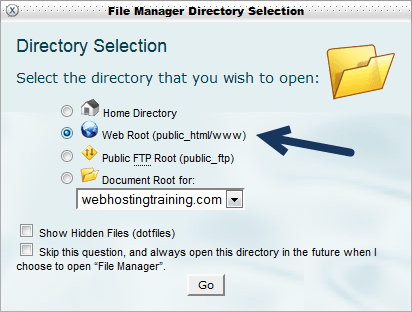 Once logged in to cPanel (reference your welcome email or get hosting from our web hosting review section), you’ll want to find the button labeled “File Manager” and open that. In the popup, Start from “Web Root (public_html/www)” and click the “Go” button.
Once logged in to cPanel (reference your welcome email or get hosting from our web hosting review section), you’ll want to find the button labeled “File Manager” and open that. In the popup, Start from “Web Root (public_html/www)” and click the “Go” button.
In the actual file manager, find the “Upload” button. Click that and then “Browse” to your downloaded WordPress file from step 1. You should now notice on the bottom right of the screen, a progress bar shows the file being uploaded from your computer to the server.
Once the file is uploaded, return to the file manager and click the Refresh button. Now you should see the WordPress zip file uploaded to your website. Simply right click the file and “Extract.” Follow the prompts and it will extract the file onto your server.
 With the files extracted, you will be left with a “wordpress” folder with all of the files necessary to run WordPress inside. Since you will not want your website to be http://www.mywebsitehere.com/wordpress/ you will want to move these files to the main root. So, double click the wordpress folder and click the “Select All” button. Once all files are blue/selected, find the “Move File” button which will bring up a screen similar to the one above.
With the files extracted, you will be left with a “wordpress” folder with all of the files necessary to run WordPress inside. Since you will not want your website to be http://www.mywebsitehere.com/wordpress/ you will want to move these files to the main root. So, double click the wordpress folder and click the “Select All” button. Once all files are blue/selected, find the “Move File” button which will bring up a screen similar to the one above.
Congrats. You have now uploaded and placed all of the files required to run WordPress on your web host! Using this method of uploading ensures that no files are corrupted or skipped because we didn’t upload each individual file separately via FTP.
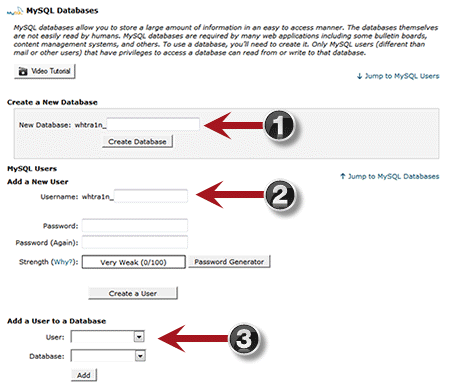 Now we need to go back to the file we opened in our text editor from step 3. With it open, return to cPanel and find the “Databases” section and click the “MySQL Databases” button.
Now we need to go back to the file we opened in our text editor from step 3. With it open, return to cPanel and find the “Databases” section and click the “MySQL Databases” button.
The screenshot to the left has been edited to only show the sections you should be looking for. Referencing this screenshot:
The final step to your wp-config.php editing is to add the authentication keys and salts which will help secure your WordPress installation. Go to the WordPress salt webpage and it will generate unique phrases automatically. Just copy all lines to your clipboard and replace the 8 define lines with the content in your clipboard.
Save the wp-config.php. You are done editing this file.
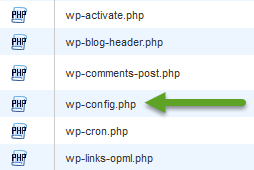 The final step is to upload your wp-config.php file to the server. Go back to the cPanel control panel, click File Manager (location Web Root again), click Upload, click Browse, select your newly saved wp-config.php file and begin the upload.
The final step is to upload your wp-config.php file to the server. Go back to the cPanel control panel, click File Manager (location Web Root again), click Upload, click Browse, select your newly saved wp-config.php file and begin the upload.
After the file is uploaded, return to the file manager, click refresh and verify that you have a wp-config.php file located along with your other WordPress files as shown in the screenshot.
Now your WordPress should be ready for install. Visit your website and you should see a language selection option. Click your desired language, click the blue “Continue” button and finally, fill out the site information including Site Title, login username, login password, your email address and make sure the check box “Allow search engines to index this site” is checked. Simply click “Install WordPress” and the setup will configure your database and prepare your site for first-time use.
Congratulations! Your WordPress site is now ready for use. After clicking “Install WordPress,” you’ll be taken to the WordPress Admin Dashboard where you can start configuring your website, add posts, add pages and much more. You may also visit your main website URL and verify that your site is showing default content. At the time of this review, the setup uses the default “Twenty Fifteen” theme.
In the coming weeks, months and years, we will continue creating guides to help you get the most of your new WordPress website. We’re going to show you how to change WordPress themes, add WordPress Plugins, teach you how to configure your WordPress and much more.
What would you like us to cover here? How did you like this guide? Let us know in the comment section below!